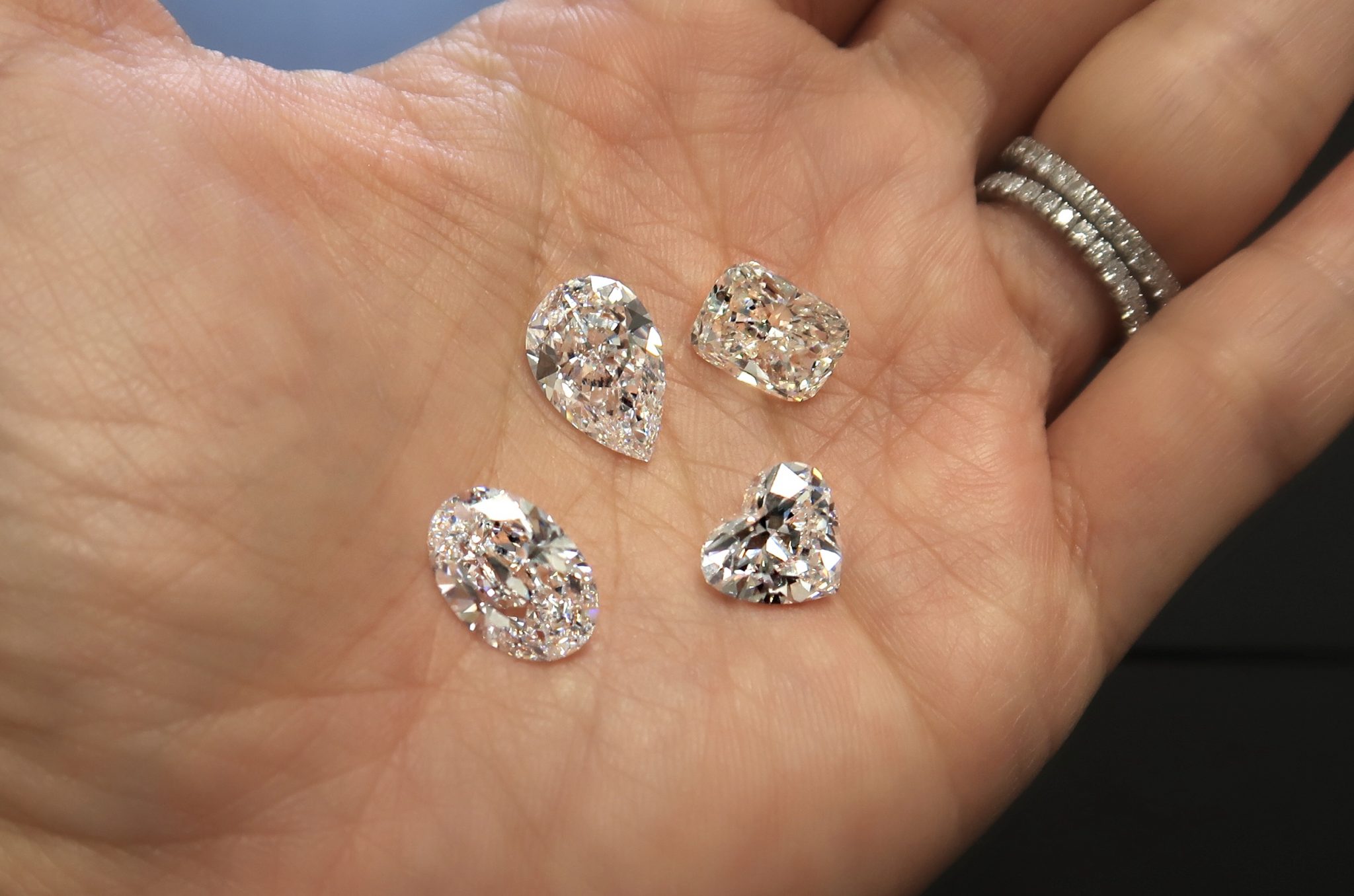Table of Contents
- Introduction
- What Are Diamond Substitutes?
- Characteristics of Diamond Substitutes
- Types of Diamond Substitutes
- Pros and Cons of Diamond Substitutes
Introduction
Diamonds have long been synonymous with luxury and elegance, coveted for their dazzling sparkle and timeless allure. However, the soaring prices of natural diamonds have led many consumers to explore alternative options that offer similar beauty at a fraction of the cost. Enter the world of diamond substitutes – a diverse array of gemstones and lab-created materials that mimic the appearance of diamonds while offering unique advantages of their own. In this comprehensive guide, we’ll embark on a journey to discover the various types of diamond substitutes, their characteristics, and how they compare to natural diamonds.
What Are Diamond Substitutes?
Synthetic Diamonds
Synthetic diamonds, also known as lab-grown or cultured diamonds, are created in controlled laboratory environments using advanced technology that replicates the natural process of diamond formation. These diamonds have the same chemical composition, crystal structure, and physical properties as natural diamonds, making them virtually indistinguishable to the naked eye.
Diamond Simulants
Diamond simulants are materials that resemble diamonds in appearance but have different chemical compositions and properties. Unlike synthetic diamonds, simulants do not possess the same atomic structure as natural diamonds. Instead, they are crafted to mimic the brilliance and sparkle of diamonds using various materials and techniques.
Characteristics of Diamond Substitutes
Hardness
Diamonds are renowned for their exceptional hardness, scoring a perfect 10 on the Mohs scale of mineral hardness. Synthetic diamonds boast the same level of hardness as natural diamonds, making them highly durable and resistant to scratching or chipping. In contrast, diamond simulants may have varying degrees of hardness depending on the material used.
Brilliance
The brilliance of a diamond refers to its ability to reflect light and produce a dazzling sparkle. Synthetic diamonds exhibit similar brilliance to natural diamonds due to their identical crystal structure and optical properties. Diamond simulants may also possess high brilliance, although the degree can vary depending on factors such as cut and clarity.
Color
Natural diamonds come in a spectrum of colors, ranging from colorless to fancy vivid hues such as pink, blue, and yellow. Synthetic diamonds can be produced in a wide range of colors through the introduction of trace elements during the growth process. In contrast, diamond simulants typically exhibit consistent coloration and may lack the natural color variations found in diamonds.
Clarity
Diamond clarity refers to the presence of internal flaws (inclusions) and surface blemishes in a diamond. Synthetic diamonds can achieve exceptional clarity levels comparable to the highest-grade natural diamonds, thanks to the controlled environment of the laboratory. Diamond simulants may have varying levels of clarity depending on the manufacturing process and the quality of the material.
Durability
Durability is a crucial factor to consider when choosing a diamond substitute, especially for everyday wear and engagement rings. Synthetic diamonds are prized for their exceptional durability and resistance to wear and tear, making them an ideal choice for jewelry that requires long-term durability. Diamond simulants may vary in durability depending on the material used, with some being more prone to scratching or abrasion.
Types of Diamond Substitutes
Moissanite
Moissanite is a naturally occurring mineral that is often used as a diamond simulant due to its brilliance and hardness. Lab-created moissanite exhibits exceptional sparkle and fire, lab made diamonds, rivaling that of natural diamonds. It is an affordable alternative to diamonds and is available in various shapes and sizes.
Cubic Zirconia (CZ)
Cubic zirconia is one of the most popular diamond simulants due to its affordability and diamond-like appearance. It is a synthetic material that closely resembles diamonds in terms of brilliance and clarity. Cubic zirconia is often used as a budget-friendly alternative for engagement rings and fashion jewelry.
White Sapphire
White sapphire is a natural gemstone that is sometimes used as a diamond substitute for its hardness and clarity. While white sapphire lacks the fiery brilliance of diamonds and moissanite, it offers a subtle, understated sparkle that appeals to those seeking a more understated look. White sapphire is an excellent choice for classic and timeless jewelry designs.
White Topaz
White topaz is another natural gemstone that is occasionally used as a diamond substitute for its affordability and clarity. While white topaz lacks the brilliance and fire of diamonds, it exhibits a subtle sparkle that can be enhanced through expert faceting and cutting. White topaz is an excellent option for budget-conscious consumers looking for an elegant and versatile gemstone.
Synthetic Diamonds
Synthetic diamonds, as mentioned earlier, are lab-grown diamonds that possess the same chemical and physical properties as natural diamonds. They are available in a wide range of colors, sizes, and clarities, making them a versatile choice for jewelry design. Synthetic diamonds offer excellent value for money and are ethically sourced, making them an appealing option for environmentally conscious consumers.
Pros and Cons of Diamond Substitutes
Moissanite
Pros:
- Exceptional brilliance and fire
- High durability and scratch resistance
- Affordable price point
- Ethically sourced and environmentally friendly
Cons:
- Slightly lower hardness compared to diamonds
- Limited availability in certain sizes and shapes
- Some individuals may prefer the uniqueness of natural diamonds
Cubic Zirconia (CZ)
Pros:
- Affordable and budget-friendly
- Excellent brilliance and clarity
- Wide range of shapes and sizes available
- Versatile and suitable for various jewelry designs
Cons:
- Prone to scratching and abrasion over time
- May lack the durability of natural or synthetic diamonds
- Some individuals may prefer the prestige of natural diamonds
White Sapphire
Pros:
- Exceptional hardness and durability
- Natural gemstone with subtle sparkle
- Ethically sourced and environmentally friendly
- Available in various sizes and shapes
Cons:
- Lower brilliance compared to diamonds and moissanite
- Limited availability in larger sizes
- May not appeal to those seeking a high-impact sparkle
White Topaz
Pros:
- Affordable and budget-friendly
- Subtle sparkle and clarity
- Versatile gemstone suitable for various jewelry designs
- Widely available in different sizes and shapes
Cons:
- Lower brilliance compared to diamonds and moissanite
- Prone to scratching and abrasion over time
- May lack the prestige associated with diamonds
Synthetic Diamonds
Pros:
- Identical chemical and physical properties to natural diamonds
- Exceptional brilliance, hardness, and durability
- Ethically sourced and environmentally friendly
- Wide range of colors, sizes, and clarities available
Cons:
- Higher price point compared to some other diamond substitutes
- Limited availability in certain sizes and shapes
- Some individuals may prefer the rarity and exclusivity of natural diamonds
How to Choose the Right Diamond Substitute
Choosing the right diamond substitute requires careful consideration of several factors, including budget, appearance preferences, ethical considerations, and intended usage.
Budget
One of the primary factors to consider when choosing a diamond substitute is your budget. While natural diamonds can be prohibitively expensive for many consumers, diamond substitutes offer a more affordable alternative without sacrificing beauty or quality. Consider how much you are willing to spend and explore options that fit within your budgetary constraints.
Appearance Preferences
Another important consideration is your appearance preferences, including the desired level of brilliance, color, and clarity. If you prioritize sparkle and fire, moissanite or cubic zirconia may be the ideal choice. Alternatively, if you prefer a more subtle sparkle, white sapphire or white topaz may better suit your preferences. Take the time to examine different diamond substitutes in person to determine which one aligns with your aesthetic preferences.
Ethical Considerations
Ethical considerations are becoming increasingly important for consumers who are mindful of the environmental and social impact of their purchases. Synthetic diamonds are considered a more ethical choice than natural diamonds, as they are produced in controlled laboratory environments without the environmental and social issues associated with diamond mining. Consider opting for a synthetic diamond or other ethically sourced diamond substitute to ensure your purchase aligns with your values.
Occasion and Usage
Lastly, consider the occasion and intended usage of the jewelry piece when choosing a diamond substitute. If you’re purchasing an engagement ring or wedding band that will be worn daily, prioritize durability and scratch resistance. Alternatively, if you’re buying a fashion accessory or occasional wear jewelry, you may have more flexibility in terms of material and design.
Comparing Diamond Substitutes to Natural Diamonds
When comparing diamond substitutes to natural diamonds, it’s essential to consider various factors, including cost, brilliance, durability, and ethical concerns.
Cost
One of the most significant advantages of diamond substitutes is their affordability compared to natural diamonds. While natural diamonds can command exorbitant prices due to their rarity and prestige, diamond substitutes offer a cost-effective alternative without compromising on beauty or quality. Synthetic diamonds, moissanite, and cubic zirconia are particularly popular choices for budget-conscious consumers seeking high-quality gemstones at a fraction of the cost of natural diamonds.
Brilliance
Brilliance is a key characteristic of diamonds that refers to their ability to reflect light and produce a dazzling sparkle. While natural diamonds are prized for their exceptional brilliance and fire, diamond substitutes such as moissanite and cubic zirconia can rival or even surpass the sparkle of natural diamonds. These synthetic gemstones are expertly cut and faceted to maximize their brilliance, creating stunning jewelry pieces that catch the eye and captivate the imagination.
Durability
Durability is another important consideration when comparing diamond substitutes to natural diamonds, especially for jewelry that will be worn daily or subjected to everyday wear and tear. Synthetic diamonds, moissanite, and white sapphire are renowned for their exceptional hardness and durability, making them ideal choices for engagement rings, wedding bands, and other high-impact jewelry pieces. These diamond substitutes are resistant to scratching, chipping, and damage, ensuring that your jewelry retains its beauty and brilliance for years to come.
Ethical Concerns
Ethical concerns surrounding the diamond industry have prompted many consumers to seek out alternative options that are more environmentally sustainable and socially responsible. Natural diamonds are often associated with issues such as environmental degradation, human rights abuses, and conflict financing, leading some consumers to opt for synthetic diamonds or other ethically sourced diamond substitutes. By choosing a synthetic diamond or lab-created gemstone, you can enjoy the beauty of a diamond without contributing to the negative impacts of diamond mining.
Popular Misconceptions About Diamond Substitutes
Despite their growing popularity and acceptance, diamond substitutes are still subject to various misconceptions and myths. Let’s debunk some of the most common misconceptions about diamond substitutes:
Lack of Brilliance
One common misconception about diamond substitutes is that they lack the brilliance and sparkle of natural diamonds. While it’s true that diamond substitutes may have different optical properties compared to natural diamonds, many synthetic gemstones such as moissanite and cubic zirconia are expertly cut and faceted to maximize their brilliance and fire. These diamond substitutes can rival or even surpass the sparkle of natural diamonds, creating stunning jewelry pieces that dazzle and delight.
Durability Issues
Another misconception about diamond substitutes is that they lack the durability and longevity of natural diamonds. While it’s true that some diamond simulants may be more prone to scratching or abrasion compared to natural diamonds, synthetic diamonds, moissanite, and white sapphire are renowned for their exceptional hardness and durability. These diamond substitutes are resistant to wear and tear, ensuring that your jewelry remains beautiful and pristine for years to come.
Ethical Concerns
Some consumers mistakenly believe that all diamond substitutes are ethically superior to natural diamonds. While it’s true that synthetic diamonds and lab-created gemstones are free from the environmental and social issues associated with diamond mining, not all diamond substitutes are created equal in terms of ethical sourcing. It’s essential to research the origins of the gemstones and choose reputable suppliers who adhere to strict ethical and environmental standards.
Caring for Diamond Substitutes
Proper care and maintenance are essential for preserving the beauty and brilliance of diamond substitutes. Follow these tips to keep your jewelry looking its best:
Cleaning
Regular cleaning is crucial for removing dirt, oil, and debris that can dull the sparkle of your diamond substitute jewelry. Use a gentle jewelry cleaner and a soft-bristled brush to clean your gemstones regularly, taking care to avoid harsh chemicals or abrasive cleaners that can damage the surface.
Storage
Store your diamond substitute jewelry in a clean, dry place away from other jewelry pieces to prevent scratches and damage. Consider using a soft cloth or jewelry pouch to protect your gemstones from dust, moisture, and sunlight when not in use.
Maintenance
Schedule regular maintenance checks with a qualified jeweler to ensure that your diamond substitute jewelry remains in optimal condition. Inspect your gemstones for any signs of damage or wear and have them professionally cleaned and inspected as needed to maintain their beauty and brilliance.
Trends in Diamond Substitutes
The popularity of diamond substitutes continues to rise as consumers seek affordable and ethically sourced alternatives to natural diamonds. Here are some notable trends in the world of diamond substitutes:
Rise in Popularity
Diamond substitutes such as synthetic diamonds, moissanite, and cubic zirconia have experienced a surge in popularity in recent years as consumers become more aware of their benefits and advantages. These affordable and visually stunning gemstones offer a viable alternative to natural diamonds for a wide range of jewelry applications, from engagement rings to fashion accessories.
Celebrity Endorsements
Celebrities and influencers have played a significant role in popularizing diamond substitutes, with many opting for synthetic diamonds and other lab-created gemstones for their engagement rings and red carpet appearances. High-profile endorsements from celebrities such as Emma Stone, Penelope Cruz, and Olivia Wilde have helped to destigmatize diamond substitutes and showcase their beauty and versatility to a global audience.
Customization Options
Advancements in technology and manufacturing techniques have expanded the customization options available for diamond substitutes, allowing consumers to create bespoke jewelry pieces that reflect their unique style and personality. From custom-cut moissanite engagement rings to personalized cubic zirconia earrings, the possibilities are endless for creating one-of-a-kind jewelry designs that make a statement without breaking the bank.
Conclusion
In conclusion, diamond substitutes offer a compelling alternative to natural diamonds for consumers seeking beauty, durability, and value. Whether you opt for a synthetic diamond, moissanite, cubic zirconia, or another alternative gemstone, the key is to choose a diamond substitute that aligns with your preferences, budget, and ethical considerations. With their exceptional brilliance, durability, and affordability, diamond substitutes are a shining choice for anyone looking to add a touch of sparkle to their jewelry collection. So why wait? Explore the world of diamond substitutes today and discover the perfect gemstone for your next jewelry masterpiece!












